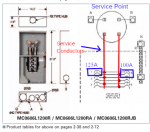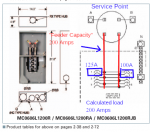wwhitney
Senior Member
- Location
- Berkeley, CA
- Occupation
- Retired
A 2017 NEC question, so that 2020 NEC issues of one service disconnect per enclosure and an outdoor emergency disconnect don't apply:
Looking through Articles 215, 220, and 230 for reference to 125% for continuous loads, I just find 215.2(A)(1)(a) (minimum feeder size), 215.3 (overcurrent protection), and 230.42(A)(1) (service-entrance conductors minimum size). In particular, I don't find an article 230 equivalent of 215.3, and 230 Part VII on OCPD doesn't mention size. 230.79 does say the service disconnecting means has to be rated for calculated load, but does not mention a 125% factor, so that would just be continuous + non-continuous loads.
Then say you have a residential underground service where the underground service conductors terminate directly on a meter/main panel, so there are no service-entrance conductors (to keep things simple). If that meter/main has just a single main breaker, then that breaker supplies a feeder subject to 215.2(A)(1)(a), and that OCPD is subject to 215.3 for sizing. That means the OCPD would be sized with a 125% factor for continuous loads, causing the meter/main to be similarly sized.
Now suppose you instead have two main breakers in your meter/main, supplying two separate feeders, one with a calculated load of 100A continuous, and one with a calculated load of 100A non-continuous. Then as I understand the above sections, you could use a 200A rated meter/main, with one 125A breaker for the continuous loads, and one 100A for the non-continuous loads. This effectively avoids the 125% factor for the service equipment.
Is that all correct?
Thanks,
Wayne
Looking through Articles 215, 220, and 230 for reference to 125% for continuous loads, I just find 215.2(A)(1)(a) (minimum feeder size), 215.3 (overcurrent protection), and 230.42(A)(1) (service-entrance conductors minimum size). In particular, I don't find an article 230 equivalent of 215.3, and 230 Part VII on OCPD doesn't mention size. 230.79 does say the service disconnecting means has to be rated for calculated load, but does not mention a 125% factor, so that would just be continuous + non-continuous loads.
Then say you have a residential underground service where the underground service conductors terminate directly on a meter/main panel, so there are no service-entrance conductors (to keep things simple). If that meter/main has just a single main breaker, then that breaker supplies a feeder subject to 215.2(A)(1)(a), and that OCPD is subject to 215.3 for sizing. That means the OCPD would be sized with a 125% factor for continuous loads, causing the meter/main to be similarly sized.
Now suppose you instead have two main breakers in your meter/main, supplying two separate feeders, one with a calculated load of 100A continuous, and one with a calculated load of 100A non-continuous. Then as I understand the above sections, you could use a 200A rated meter/main, with one 125A breaker for the continuous loads, and one 100A for the non-continuous loads. This effectively avoids the 125% factor for the service equipment.
Is that all correct?
Thanks,
Wayne



